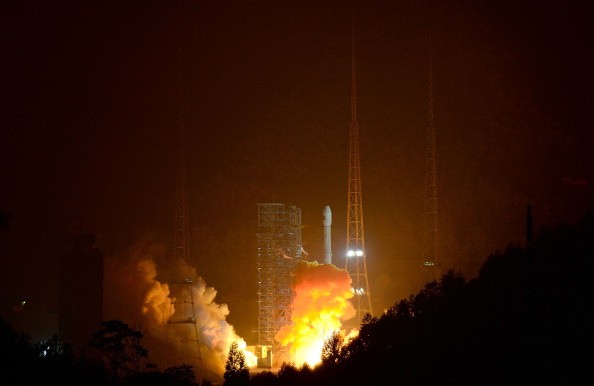China Microgravity Satellite to Uncover Mysteries of Weightlessness
| Jenia Cane | | Apr 07, 2016 02:31 AM EDT |
(Photo : ChinaFotoPress/Getty Images) A Long March-3B carrier rocket carrying China's Chang'e-3 lunar probe takes off from the Xichang Satellite Launch Center on Dec. 2, 2013 in Xichang, China.
China's first microgravity satellite, the SJ-10, took off into space on Wednesday, fueling the hopes of scientists that they will finally be able to find answers to questions, which range from biology to the physical properties of substances within a weightless environment.
Propelled by a Long March 2-D rocket, the recoverable satellite fired off from the Jiuquan Satellite Launch Center in Gansu province at 1:38 am, and will remain in orbit for a couple of days to conduct various experiments before descending back to Earth, China Daily reported.
Like Us on Facebook
"Microgravity - the environment created during weightlessness - is an extreme condition that changes every physical phenomenon we are familiar with, which is why microgravity research has been a science hot spot internationally," explained Hu Wenrui, chief scientist of the China microgravity satellite, who is also a prominent physicist and a member of the Chinese Academy of Sciences.
Underscoring the importance of the experiments to be carried out by the SJ-10, Hu cited the case for liquids in which they have to be first placed in containers before they can be properly observed.
However, in a microgravity environment, liquids can float, and therefore, making it possible for researchers to better determine its characteristics and understand its chemical reactions, which can lead to the development of new materials.
Over the years, it has been a practice for microgravity experiments to be carried out in various space facilities, which include as space stations, shuttles, research rockets or orbiting satellites.
A research rocket is considered as the cheapest option for such kind experiments, as it can create at least a 10-minute period of weightlessness for microgravity experiments. On the other hand, a typical satellite can stay a couple weeks in a gravity-free environment.
This makes the task of the China microgravity satellite both interesting and challenging, as it is designed to return to Earth after the experiments are completed.
"The recoverable satellite is a useful and efficient tool for microgravity experiments, compared with space stations and research rockets," Hu said.
He noted that space shuttles and orbiting space stations are much more costly, yet less flexible than satellites which can get the job done.
Shaped like a bullet, SJ-10 will carry out 28 scientific inquiries., eleven of which will be recovered on Earth, while the other experiments will remain in orbit.
The other tasks to be carried out by the China microgravity satellite include research in fluid physics, studies to enhance fire safety for manned spaceflight, biological experiments to improve human health, as well as experiments related to coal combustion and materials processing.
Tagschina, Microgravity Satellite, Chinese Academy of Sciences
©2015 Chinatopix All rights reserved. Do not reproduce without permission
EDITOR'S PICKS
-

Did the Trump administration just announce plans for a trade war with ‘hostile’ China and Russia?
-

US Senate passes Taiwan travel bill slammed by China
-

As Yan Sihong’s family grieves, here are other Chinese students who went missing abroad. Some have never been found
-

Beijing blasts Western critics who ‘smear China’ with the term sharp power
-

China Envoy Seeks to Defuse Tensions With U.S. as a Trade War Brews
-

Singapore's Deputy PM Provides Bitcoin Vote of Confidence Amid China's Blanket Bans
-

China warns investors over risks in overseas virtual currency trading
-

Chinese government most trustworthy: survey
-

Kashima Antlers On Course For Back-To-Back Titles
MOST POPULAR
LATEST NEWS
Zhou Yongkang: China's Former Security Chief Sentenced to Life in Prison

China's former Chief of the Ministry of Public Security, Zhou Yongkang, has been given a life sentence after he was found guilty of abusing his office, bribery and deliberately ... Full Article
TRENDING STORY

China Pork Prices Expected to Stabilize As The Supplies Recover

Elephone P9000 Smartphone is now on Sale on Amazon India

There's a Big Chance Cliffhangers Won't Still Be Resolved When Grey's Anatomy Season 13 Returns

Supreme Court Ruled on Samsung vs Apple Dispute for Patent Infringement

Microsoft Surface Pro 5 Rumors and Release Date: What is the Latest?











